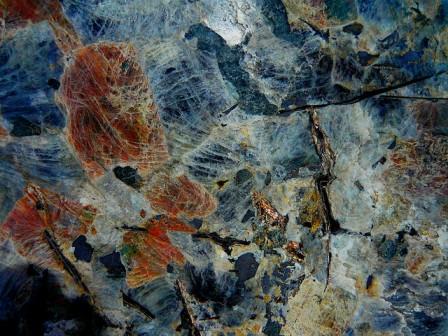
Major mining companies are looking to enter the potash business, or expand existing operations, as they look for increased demand from developing nations such as China, India and Brazil.
“This is a solid business and the big mining companies agree. If they can find a way to participate in it, they will.” Mark Connelly, New York brokerage Sterne Agee.
BHP Billiton – In the spring of 1869 a German Chemist named Charles Rasp immigrated to Australia for his health. Unable to find work in his chosen trade Charles learned to ride a horse and began wrangling sheep. One day, while out riding his horse at Broken Hill, he discovered mineralized rock. He took out a mining lease, punched holes in the ground and eventually found rich veins of silver. The Broken Hill Proprietary Company – BHP – was incorporated in 1885 while mining silver and lead at Broken Hill in western New South Wales.
Billiton was a mining company that got its start in September 1860 when the articles of association were approved by a meeting of shareholders in the Groot Keizerhof Hotel in The Hague, Netherlands. Shortly afterwards the company acquired the mineral rights to the tin-rich islands of Banka and Billiton off the eastern coast of Sumatra.
Nicknamed “the Big Australian”, BHP is the world’s largest mining company. It was created in 2001 by the merger of Australia’s Broken Hill Proprietary Company and Anglo-Dutch Billiton. Today BHP produces – oil, natural gas, bauxite, aluminum, copper, silver, lead, zinc, uranium, diamonds, coal, titanium, well, you get the idea, they’re miners, they pull “stuff” out of the ground and sell it.
BHP, seeking to benefit from surging demand for fertilizer, made a $40 billion hostile bid for Potash Corp. of Saskatchewan Inc. Yielding to political pressure, Canada’s Federal government nixed the deal. BHP paid $341 million, C$8.35/share, to acquire Saskatoon’s Athabasca Potash. The acquisition gave BHP Athabasca’s Burr Project, which is located next to BHP’s Jansen Project. BHP announced on 24th June 2011, a further investment of US$488 million to support development at its Jansen Potash Project. This piece of additional capital will fund site preparation and the procurement of long lead time items during the project’s feasibility study. This funding will also enable BHP to develop the first 350 meters of the production and service shafts. The announcement takes BHP Billiton’s investment in Jansen to, so far, $1.2 billion.
Vale S.A. – Formerly known as Companhia Vale do Rio Doce (CVRD) was founded by the Brazilian Federal Government in June 1942. The company was privatized in 1997 when the Brazil Consortium bought just over 40% of the Federal Government’s stock.
Even though Vale has operations in the energy and logistics sectors both sectors combined contribute less than ten percent to Vales total revenues. Vale is a miner and controls the Brazilian iron ore industry owning all Brazilian iron ore exporters. In recent years, in an attempt to diversify its operations, Vale has made a string of purchases getting into copper, kaolin, nickel and coal. In October 2006 Vale bought Canada’s second largest mining company, Inco, for $18.9 billion. Vale also produces manganese, ferroalloys, bauxite, potash (Sergipe mine in Brazil), alumina and aluminum.
Vale S.A. has moved into the fertilizer business in a big way. In January of 2009, Vale bought Rio Tinto’s potash assets in Argentina and Saskatchewan Canada for US$850. In January 2010, Vale announced it would acquire all the shares of Bunge Participacoes e Investimentos S.A. (BPI). Vale will pay $1.65 billion US for BPI – for its wholly owned phosphate mining operations in Brazil – and another $ 2.15 billion US for its 42.3 percent in Fertilizantes Fosfatados S.A. (Fosfertil) – a leading Brazilian fertilizer company. Engineering work has started at Vales Rio Colorado solution mining potash project in Mendoza, Argentina. Estimated start-up is for the second half of 2014 with a nominal capacity of 4.3 Mt per year of potash.
Vale said it’s planning to consolidate its position in the potash industry by taking its fertilizer unit private. The change would give the Brazilian-based miner more control over the business that now represents about 2 per cent of global potash production. Vale is planning to build a $3 billion potash project in Saskatchewan, and has other potash projects in its pipeline.
Rio Tinto – A site along the Rio Tinto river in the Andalusian Province of Huelva, Spain has been mined for copper, silver, gold, and other minerals since 3000 BC. After being lost for centuries the mines were rediscovered in 1556, the Spanish government began operating them in 1724 but sold them in 1873 to Matheson and Co. Hugh Matheson formed a syndicate consisting of Deutsche Bank (56% ownership), Matheson (24%), and railway firm Clark, Punchard and Company (20%). The syndicate registered the Rio Tinto Company on 29 March 1873. The Rothschild family had control by the end of the 1880s.
After selling its South American and Saskatchewan (Canada) potash assets in 2009 to cut debt Rio has re-entered the potash business. The company is teaming up with North Atlantic Potash Inc. – the Canadian subsidiary of Russia’s JSC Acron, a fertilizer producer – to hunt for potash in Saskatchewan. A joint venture between Aluminum Corp. of China (Chinalco) and Rio Tinto has received approval for exploration in China. The JV will initially focus on exploring for copper in China but has plans to expand into coal and potash.
K+S AG – Bought Canada’s Potash One, the previous owners of Legacy, in a 2010 deal worth $434 million. Potash prices at the time were 40% lower than today. After saying on March 8th 2011 that it expects global demand for potash to rise 3-5 percent per annum, Europe’s largest (and the worlds fourth largest) potash producer, Germany’s K+S AG said on November 29th 2011 that it will move forward with construction of its $3.2 billion Legacy project in Saskatchewan.
The reality is the potash story is just starting. Unlike other resource plays there is no cycle, demand is expected to rise year over year making potash an excellent play in what some expect will be a long term agricultural commodities bull market.
Future Demand – “Just when we need more soil to feed the 10 billion people of the future, we’ll actually have less—only a quarter of an acre of cropland per person in 2050, versus the half-acre we use today on the most efficient farms.” David Montgomery, author of the 2007 book Dirt: The Erosion of Civilizations
Fertilizers are becoming increasingly important for many reasons:
- There’s 220,000 people being born every day, that’s 220,000 more mouths to feed every day;
- An increasing disposable income in a growing middle class, more money in more pockets means more and more people climbing the protein ladder;
- Loss of arable land, topsoil degradation;
- Desertification and climate change;
- The Green Revolution’s impact on crop production is declining, in some cases reversing;
- Some older mines are going to become more inefficient or be lost;
- Underutilization of potash in many countries;
- Demand from the countries whose economies are starting to develop and have the ability to get into farming;
- Security of supply.
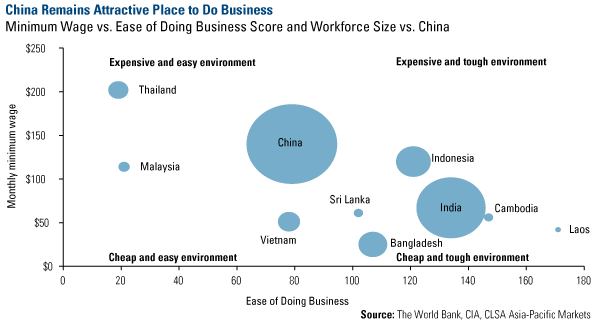
At the CLSA AsiaUSA Forum in San Francisco earlier this month, numerous opportunities for U.S. businesses in China were discussed. Factors affecting growth in China are the Asian middle class, an increasing urbanization rate, and additional disposable income. The latter has been partially spurred by recent increases in wages. In fact, many people in China saw their wages rise 20 to 30 percent last year.
However, while these wage increases have been positive to the Chinese consumer and the companies which sell the goods, they have prompted many people to ask me how rising wages affect China’s status as a low-cost manufacturing hub for the world. Does this reduce the profitability of companies that expect to continue to benefit from the country? And, will China continue to drive resource demand?
This is where CLSA’s more balanced view of China’s business landscape is not only helpful, but essential. It is not enough to look at rising wages to appreciate how attractive China is for businesses. To get a better understanding, let’s compare three factors—the World Bank’s Ease of Doing Business score, minimum wage and workforce size—across several Asian markets. The World Bank annually analyzes regulations that either enhance or constrain business activity among 183 economies. For a business that wants to expand into different markets, this report is helpful in determining the ease or difficulty in obtaining construction permits, electricity and credit, as well as hiring workers and trading across borders.
On the World Bank’s scale, the business environment is easier in Thailand and Malaysia than in China and Vietnam, and companies would find it even more difficult to expand their businesses into Indonesia, India and Cambodia. However, Indonesia, India and Cambodia have cheaper labor markets than China or Thailand. But of all of these countries, China offers the largest labor market. CLSA says China makes for an “appealing hub for manufacturing” when you evaluate its unique combination of strengths together.
In addition, China’s workforce is better educated and more highly skilled compared to other Southeast Asian countries, says CLSA. China was also named the “world’s most connected economy” by the United Nations Conference on Trade and Development’s Liner Shipping Connectivity Index, when it comes to how integrated global shipping networks are to enable worldwide trade. The country also has superior infrastructure and trade connectivity compared to many emerging markets, “even occasionally besting developed economies,” says CLSA.
From the article entitled, “With Rising Wages, Will China Remain a Manufacturing Hub?” by Frank Holmes. Frank Holmes is chief executive officer of U.S. Global Investors – a registered investment adviser that manages approximately $2.8 billion. The information provided herein has been provided to MiningFeeds.com by the author and, as such, is subject to our disclaimer: CLICK HERE.
Metals Economics Group Pipeline Activity Index (PAI) increased for the second consecutive month to reach a four-month high in September, driven by impressive numbers of significant drill results and a jump in initial gold resource announcements. In October, however, the increased number of significant drill results was not enough to outweigh poor financing conditions, dropping the PAI slightly.
The industry’s aggregate market cap plummeted during a rough September, falling below $1.8 trillion for the first time since August 2010. Market caps recovered to $1.96 trillion in October—still below 2011’s year-to-date monthly average of $2.23 trillion.
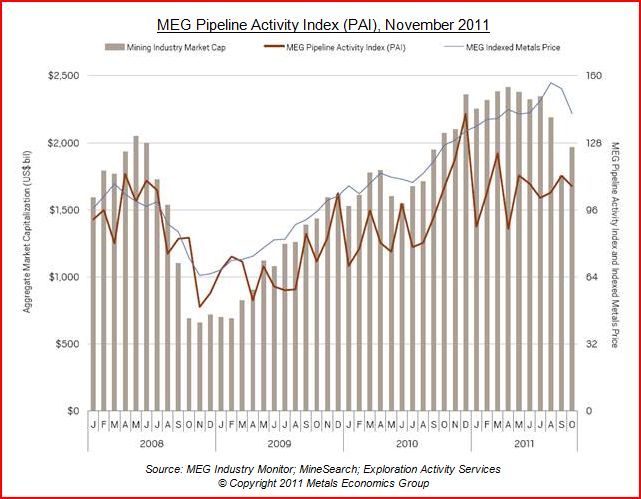
Despite softening metals prices, the number of significant drill results increased in the September-October period. The impact of recently fluctuating metals prices and ongoing market turmoil on explorers—especially juniors—will likely play out during the remainder of 2011 and into early 2012. North America, Latin America, and Australia-Pacific together accounted for 77% of the significant gold results and 86% of the base metals results in September-October—up from 68% and 72% respectively for the corresponding period in 2010.
The number of initial resources announced in September matched 2011’s one-month high. Gold led and September’s numbers presented the second-highest one-month total since 2008, which is not surprising given the steady rise in gold exploration seen throughout most of 2010 and 2011. Latin American projects accounted for four of the top five initial gold resources and two of the top five initial base metals resources, giving the region 57% of the overall in-situ value of resources announced in September-October.
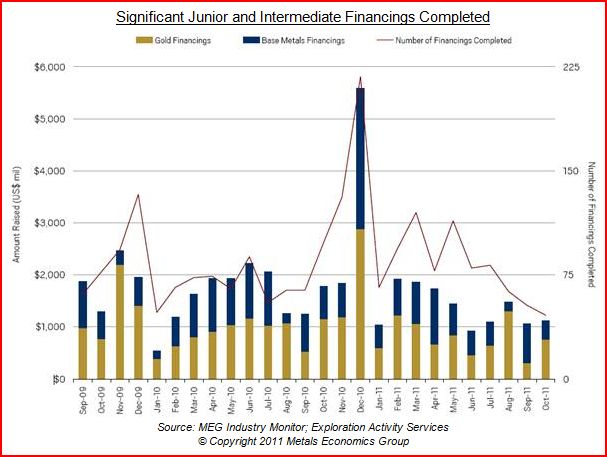
The number of significant financings (US$2 million minimum) completed by junior and intermediate companies slid for the third consecutive month in October, as already-volatile markets continued to be hampered by global growth concerns and sovereign debt problems. With $1.07 billion raised, September-October marks the lowest total for gold financings since January-February 2010. In addition, the number of base metals financings marks the lowest total for this group since May-June 2009.
From the report entitled, “Metals Economics Group Pipeline Activity Index, November 2011” by Metals Economics Group. Metals Economics Group (MEG) is a trusted source of global mining information and analysis. With three decades of comprehensive information and analysis, MEG has an unsurpassed level of experience and historical data. The information provided herein has been provided to MiningFeeds.com by the author and, as such, is subject to our disclaimer: CLICK HERE.
According to Metals Economics Group’s (MEG) Corporate Exploration Strategies, the estimated total 2011 budget for nonferrous metals exploration surged to $18.2 billion. Despite increased volatility in recent months, metals prices—the primary driver of exploration spending—have remained relatively strong in 2011, giving confidence to the industry; as a result, exploration budgets increased by $6.1 billion, up 50% from 2010 to set a new all-time high. Nonferrous exploration refers to expenditures related to precious and base metals, diamonds, uranium, and some industrial minerals; it specifically excludes iron ore, aluminum, coal, and oil and gas.
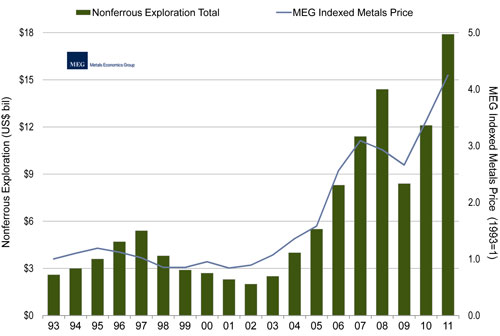
Most countries are seeing increased exploration investment in 2011, and explorers are demonstrating a higher tolerance for risk despite additional concerns and uncertainty about security, policy, and tenure in many countries. Of the 120 countries for which we documented exploration spending by the industry, those commonly perceived to be high risk account for 23% of the 2011 aggregate exploration total, up from less than 16% in 2010. The potential reward often increases the industry’s appetite for risk during periods of increased exploration spending, but exploration in high-risk countries, particularly early-stage work, is usually the first to be cut when risk levels or uncertainty increases.
The proportion of overall exploration spending dedicated to early-stage and generative work has been fairly stable over the past three years; however, at just a third of overall allocations it is historically low. The decline in grassroots’s share of spending over the past decade correlates with the upward trend in late-stage and minesite budgets, as companies spent more on late-stage projects to move them towards production or to make them attractive for acquisition, and on minesite work as a less expensive and less risky means of replacing and adding reserves. However, the number of large-scale assets advancing to development has not risen proportionately with this increased focus on late-stage projects, contributing to constraints on meaningful production increases for most metals. The apparent decline in grassroots efforts relative to late-stage and minesite exploration over the past cycle and the considerable time needed to advance a new discovery to production mean that the pool of viable, large-scale assets available for actual development is unlikely to grow in the near future.
MEG’s 2011 exploration estimate is based on information collected from almost 3,500 mining and exploration companies worldwide, of which more than 2,400 had exploration budgets in 2011. The 2,400 companies (each budgeting at least $100,000) together budgeted $16.3 billion for nonferrous exploration in 2011. Including estimates for the budgets that MEG could not obtain, the 2011 worldwide exploration budget totals $18.2 billion.
From the report entitled, “Exploration budgets up 50% – surging to new all-time high” by Metals Economics Group. Metals Economics Group (MEG) is a trusted source of global mining information and analysis. With three decades of comprehensive information and analysis, MEG has an unsurpassed level of experience and historical data. The information provided herein has been provided to MiningFeeds.com by the author and, as such, is subject to our disclaimer: CLICK HERE.
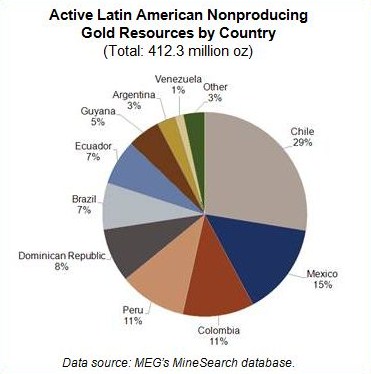
According to a recent mining industry report by Metals Economics Group (MEG), Latin American gold production should increase more than 10% in 2011. The report states that about two thirds of Latin American production is from primary gold mines and the rest is from secondary sources, mostly copper and silver mines.
Although Chile is Latin America’s fifth largest gold producer behind Peru, Mexico, Brazil, and Argentina, it holds the largest share of gold in active non-producing projects equating to 29% of gold contained in resources under development. Mexico holds the second largest non-producing gold resources and the largest producing resources holding 28% of gold contained in producing resources.
In addition to the advanced exploration projects that are progressing from reserves development to production, early-stage exploration by junior companies is contributing to the Latin American gold project pipeline. Since 2000, junior companies’ allocations to all stages of Latin American gold exploration have increased each year except three: in 2001-02 when gold prices were languishing at the $300/oz level, and in 2009 when the equity markets collapsed. The number of exploration successes (positive drill intersections and resource increases) has followed the same general trend.
From the report entitled, “Latin American Gold Output Increases in 2011” by Metals Economics Group. Metals Economics Group (MEG) is a trusted source of global mining information and analysis. With three decades of comprehensive information and analysis, MEG has an unsurpassed level of experience and historical data. The information provided herein has been provided to MiningFeeds.com by the author and, as such, is subject to our disclaimer: CLICK HERE.

ANGLO American’s (LSE:AAL) recent corporate maneouvres have really caught the eye, especially the sale of its 24.5% stake in Anglo American Sur, its Chile base metals company, to Mitsubishi.
Analysts have described it as ‘fancy footwork’ and ‘corporate theater’; another, in martial terms as Anglo having ‘outflanked’ Codelco. Codelco is Chile’s state-owned mining company that last month announced its intention to exercise its option agreement over Anglo American Sur in January.
For me, I can only wonder, again, at the power of the team. In rejecting Xstrata’s (LSE:XTA) merger of equals proposal two years ago, Anglo CEO Cynthia Carroll not only saved her job but got herself a steely board of directors.
As a colleague of mine once said, the softest part of Sir John Parker, the industrialist drafted into Anglo at the time of the Xstrata bid, is his tooth enamel. The swiftness of the Mitsubishi move has the paws of a sly fox all over it. I’d love to know how this plan was hatched, when, and by whom.
In any event, Anglo has at a stroke achieved a few things. It has increased the valuation of 100% of Anglo American Sur 10% to $22 billion against the $19.9 billion value attached to the company by Codelco (and financier, Mitsui).
Secondly, Anglo seems confident it has reduced the amount of the stake over which Codelco has its lower value option agreement. So if Codelco exercises its option, the company will be shared as follows: Anglo American (51%), Mitsubishi (24.5%) and Codelco (24.5%).
Thirdly, Anglo also has the optionality of dispensing the remaining 24.5% Codelco still has rights over which the government can only do in January. An Anglo spokesperson confirmed the group could have sold 50% of Anglo Sur if it had wanted.
Assuming Anglo doesn’t do this, and waits for Codelco to exercise its option, it will stand to bag some $8.4 billion (before capital gains tax on the Mitsubishi sale which is a whopping $1 billion). This fourth element of Anglo’s coup raises the question again: what will Anglo do with the cash?
One analyst, who asked not to be named, said there would be enough cash left over to build a balance sheet robust enough to buy out the Oppenheimer family’s stake in De Beers – the other corporate manoeuvre which earned Carroll kudos earlier this month – and take out Kumba Iron Ore minority shareholders, equal to 35% of total shares in issue valued at some $7 billion.
Shares in Kumba Iron Ore (JSE:KIO) have increased 11.5% since November 1. It’s worth noting that the volatility in iron ore prices didn’t much affect the company given the niche value of its product suggesting the possibility of a takeout might be getting priced into the share, perhaps.
From the article entitled, “Anglo may line up Kumba Iron Ore” by David McKay of Miningmx. Miningmx is a leading online publication providing news, editorial and analysis on the African resources sector. The information provided herein has been provided to MiningFeeds.com by the author and, as such, is subject to our disclaimer: CLICK HERE.
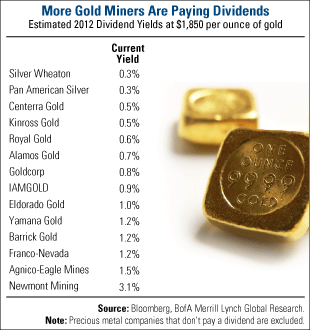
With money markets and Treasuries yielding next to nothing these days, investors are finding income in new places. One area those investors should consider is gold mining. With gold rising in value, mining companies are reaping record profit margins, yet the stock prices are depressed due to lack of investor interest. A solution for both gold companies and investors may be dividends, specifically gold-linked dividends.
Several top-tier gold producers that are benefiting from higher gold prices have begun to share a portion of their profits with shareholders via a dividend payout. Thirteen of the world’s largest gold producers are expected to pay nearly $2 billion in dividends this year, according to MineFund, making it the largest payment in gold stock history. The Financial Post also reported that miners’ dividend payments are up 75 percent on a year-over-year basis, compared to a 26 percent increase in 2010.
Yamana Gold (TSX:YRI) is just one of several large producing miners to report increased revenues, expanding cash flows and record adjusted earnings. Because of the company’s strong balance sheet, Yamana increased its dividend for the second time this year to $0.20 per share annually. When discussing the enhanced payouts, CEO Peter Marrone cited that the company “continued to focus on delivering growth across all measures, enhancing shareholder value and generating significant cash flow in the third quarter.”
The latest payout represents a 67 percent increase over the past 12 months and the second increase this year.
Other miners, such as Newmont Mining (NYSE:NEM), have implemented a gold-linked dividend, which means that the amount of the dividend the shareholder receives will be linked to the average price of gold. As the yellow metal trades higher, the company would increase dividends paid out to its investors. Conversely, if gold falls in value, dividend payouts would decrease.
Eldorado Gold (TSX:ELD) has also come out with a similar dividend policy, linking dividends to the price of gold. As shown in the chart below, Eldorado Gold anticipates its next dividend payout will be 67 percent higher than the previous quarter.
Barrick Gold (TSX:ABX) also announced a third quarter dividend increase during its earnings release. Over the past five years, the company has increased its dividend by more than 170 percent on a quarterly basis. The company’s latest dividend—$0.15 per share— represents a 25 percent increase from the prior quarter.
Barrick estimates its third quarter gold cash margins have increased by 55 percent on a year-over-year basis, driven by the company’s leverage to higher gold prices. The company says it will continue to offer its shareholders a rising income stream while also expanding operations in Pueblo Viejo, Pascua-Lama and Nevada.
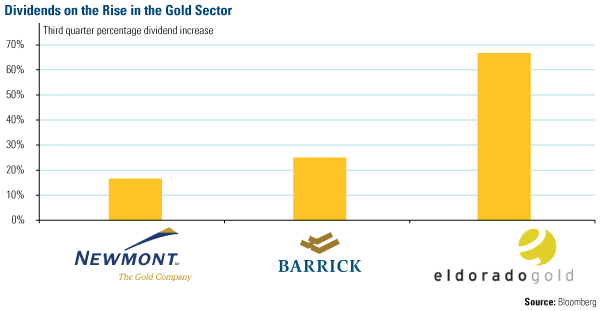
While the share prices of these miners have been punished in 2011, increasing dividends allow investors to get “paid to wait” for the market to turn around. The dividends are a cash incentive for investors to hold shares of the company and allow them to participate in rising earnings. We like that idea.
From the article entitled, “Get Paid to Play Gold” by Frank Holmes. Frank Holmes is chief executive officer of U.S. Global Investors – a registered investment adviser that manages approximately $2.8 billion. The information provided herein has been provided to MiningFeeds.com by the author and, as such, is subject to our disclaimer: CLICK HERE.
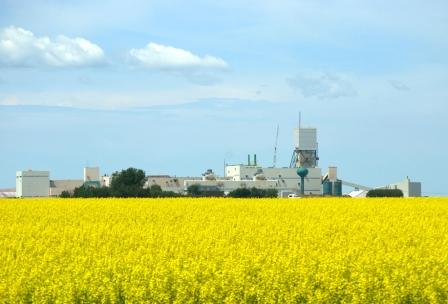
Higher crop yields are needed in order to feed today’s global population of seven billion so strong fertilizer prices are sustainable. Over the next fifty years, as we add another 4.5 billion people to the world’s population, global demand for food will increase almost 70% if population growth predictions are correct. The sheer amount of people being born every year, the loss of arable land and the change of diet among a newly prosperous, urban population in developing countries are the most important factors stoking the rise in global food demand.
As demand for food rises, so does the requirement for crop nutrients. Potash has unique characteristics:
- High-quality, economically viable deposits are rare;
- Major offshore markets have little or no indigenous production capability;
- Barriers to entering the business are significant;
- Potash has been historically under applied relative to nitrogen and phosphate; and,
- Limited new operational capability is expected.
A rising income means more money in the household budget. The new middle class consumers forgo plant based calories in favor of adding more protein from meat and dairy products to their diets. It takes up to eight kilograms of grain to produce one pound of beef – less for pork, chicken, milk or eggs – between 2kg and 6kg. As meat consumption soars, more grain is needed to feed more livestock. In 1995, the Chinese ate an average of 25kg of meat per person, by 2007, the Chinese were consuming 53kg of meat per person.
Enlarging and diversifying the meat supply is a first step for every developing country. In 1980, the world ate 133 million tonnes of meat and drank 342 million tonnes of milk. By 2002, consumption had increased to 239 million tonnes of meat and 487 million tonnes of milk. The United Nations Food and Agriculture Organization (FAO) estimates that by 2030 global annual consumption of meat will stand at 373 million tonnes and 736 million tonnes of milk.
Potash Corporation of Saskatchewan Inc. (TSX:POT & NYSE:POT), the world’s largest fertilizer producer by market value, doubled its third quarter earnings, reporting 94 cents per share or $826 million compared to 38 cents per share or $343 million a year ago. During the first nine-months of 2011, the company’s earnings have doubled from $1.39 per share during the same period last year to $2.73 per share today. Net income of US$826 million was the second highest Q3 profit in the company’s history – gross margin reached US$1.1-billion. Potash production was 1.9 million tonnes, a third quarter record for Potash Corp.
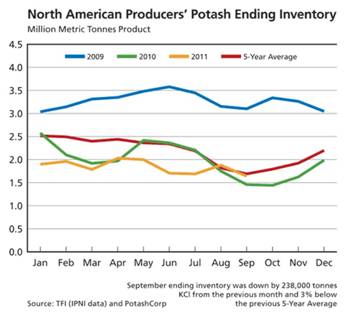
The company said demand was strong from both North American and international customers. “Crop prices remained at historically high levels [in the third quarter] and farmers continued to strive for increased production to capitalize on the economic opportunity in agriculture. As a result, demand for our potash, phosphate and nitrogen products remained strong,” commented Bill Doyle chief executive of Potash Corp. Global grain stocks remain at extremely low levels. Potash Corp. said at the beginning of the year that it would take two years of record harvests to get inventories back to comfortable levels, 2011 has been referred to as a lost year.
According to figures compiled by Bloomberg potash prices averaged 27 percent higher in the third quarter compared with a year earlier. There may be room for more upside, the cost of fertilizer as a percentage of corn revenue is 13%, 18% is the norm.
“Global potash prices have surged in 2011, driven by a tight global supply/demand balance, and with producers heavily committed through year-end, we view current price levels as being sustainable.” Don Carson, analyst, Susquehanna Financial Group.
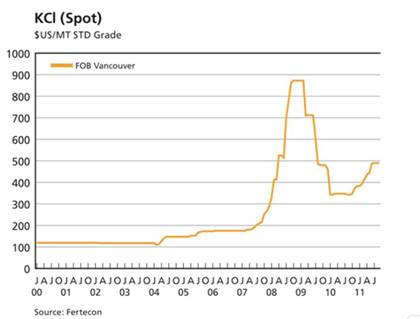

Immortalized in film by screen siren Marilyn Monroe, it’s a well known fact that diamonds are a girl’s best friend. But are diamonds an investor’s best friend? In the mid-1990s they certainly were when there was a bona fide “diamond rush” in Canada after diamonds were discovered by Dia Met Minerals in Canada’s north. Dia Met Minerals, and its share in the coveted Ekati diamond mine, were later taken-over by BHP Billiton in 2001 for $21 per share. At the time of the buy-out Dia Met Minerals controlled 28% of the Ekati mine and the deal was valued at $687 million. The Ekati mine became Canada’s first diamond-producing mine when it came into production in 1998.
With the success of Dia Met Minerals in the mid-1990s many junior mining companies were launched on the TSX-V Exchange including none other than Diamond Fields Resources, which, although they never found diamonds in Canada, did manage to discover one of the largest Nickel deposits on the planet while they were prospecting in Labrador, Newfoundland. Diamond Fields’ Voisey’s Bay nickel discovery, although somewhat happenstance, is arguably the most significant mineral discovery in Canada in the past 40 years.
But today, the lustre of diamonds has faded and the mining market is dominated by the resurgence of the precious metals, base metals and tech metals. In memory of what once was, we take a trip down nostalgia lane with Marilyn Monroe.
The MiningFeeds.com
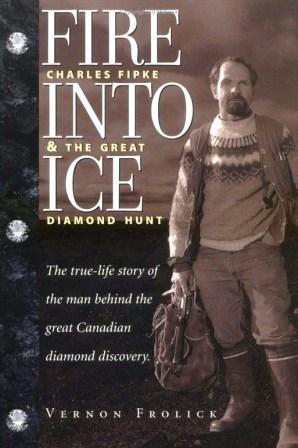
In 1969, while working in the Yukon, a geologist named Chuck Fipke needed to be rescued from a mountainside in the Mackenzie mountain range where he had been stranded for close to a week. Stewart Blusson, his boss at the time, sent in the helicopter that saved him. From then on, Fipke and Blusson became friends and prospecting partners. Between them, they changed the landscape of Canadian mining when they co-discovered the Ekati diamond mine in Canada’s arctic.
In 1981, Blusson and Fipke began searching for diamonds in the Northwest Territories, concentrating their search on indicator minerals commonly associated with kimberlite, a host rock for diamond. They found kimberlitic indicator minerals near Lac de Gras in the Northwest Territories in 1985, and their first kimberlite at Point Lake in 1991 which contained diamonds. Seven years later, in 1998, the Ekati mine opened as a joint venture between BHP Diamonds Inc. (51%), Dia Met Minerals (29%), Fipke (10%), and Blusson (10%) and the rest is, how shall we say, history. A book entitled, Fire and Ice, marks the story of Charles Fipke and the great Canadian diamond discovery.
Since 1998, the mine has produced over 50 million carats (8,888 kg / 19,595 lb) of diamonds out of six open pits. And as a result, Fipke and Blusson are now among Canada’s richest businessmen and both are active philanthropists. Stewart Blusson has earned the distinction as one of the most generous philanthropists in Canadian history with donations of more than $100 million to fund Canadian medical research and education.
In a telephone interview, MiningFeeds asked Stewart Blusson for his take on the diamond sector today – here’s what he had to say. “Most junior diamond exploration companies have stalled due to the success of other commodities. But what many people may not understand is diamond mining is so much more profitable than other mining. A rich diamond bearing pipe is the most valuable real estate on earth.” Mr. Blusson also pointed out, “Today the supply of diamonds is winding down because diamonds are not expandable like other commodities. They occur in the earth’s surface in one particular way and, by 2050, there may be nothing left to mine.”
1. Peregrine Diamonds Ltd. (TSX:PGD)
During the height of the financial crisis in November 2008, BHP Billiton elected to exercise its earn-in rights for the Chidliak diamond project. The price? $22.3-million in exploration over a two year period entitled the mining giant to a 51% interest in Peregrine Diamond’s biggest project. This marked a significant milestone in the company’s history and set the stage for a huge rally in the company’s share price from the $0.75 range to over $4.50. Since then, shares of Peregrine Diamonds have, over a three year period, trended back to the $1.00 mark.
Raymond Goldie, a senior mining analyst at Salman Partners, states in a report, “We note that BHP rarely enters into joint ventures with juniors, especially joint ventures in which the junior is, as is the case with Peregrine, the operator. BHP’s decision should not only increase the market’s confidence in the prospects of the Chidliak project, it should also increase the market’s confidence that the project can obtain financing through to production.”
A stable funding partner is a key part of the equation for a junior exploration and development diamond company since the average time frame from discovery to production is around 10 years and the costs are significant.
Is it time to revisit Peregrine Diamonds as an investor? We connected with Eric Friedland, younger brother to well-known mining venture capitalist Robert Friedland and CEO of Peregrine Diamonds, to find out what’s in store for the company – CLICK HERE – for the interview.

2. Stornoway Diamond Corp. (TSX:SWY)
A day late and a dollar short. Shareholders are hopeful the age-old idiom does not apply to Stornoway Diamond.
Stornoway’s flagship asset is the Renard Diamond Project which the company has been working on for 10 years in pursuit of becoming Québec’s first diamond mine. Current NI 43-101 compliant Indicated and Inferred Mineral Resources stand at 23.8 and 17.5 million carats respectively, with a further 23.5 to 48.5 million carats classified in the non-resource category. As Stornoway’s President & CEO, Matt Manson, pointed out during an interview with BNN on April, 2011, “Renard for us is the big value driver and big story.” During the interview, Mr. Manson also confirmed the Renard Feasibility Study was do for completion by the end of the third quarter, 2011 (September, 30th).
On September 20th, 2011, Stornoway reported their long awaited Renard Feasibility Study, which is to include an operating plan, mine plan, production schedule and cost estimates, was “nearing completion”. The company stated that, over the next several weeks, management would complete a final due diligence review in advance of its approval by the Board of Directors prior to its public release. That was seven weeks ago and still no word. And, based on some of the discussions taking place on internet message boards, investors are getting impatient. As one poster states, “Whats goin on here?…couldn’t imagine when (Stornoway) was 2.40 $ that it could go…to this level.” The company’s shares are currently trading at $1.49, down almost a $1.00 over the past four months.
With the company’s stock trading just above 52 week lows, there is another age-old idiom that shareholders of Stornoway Diamonds are very likely placing credence in – patience is a virtue.
For 5 Diamond Stocks to Watch – Part 2 – CLICK HERE.
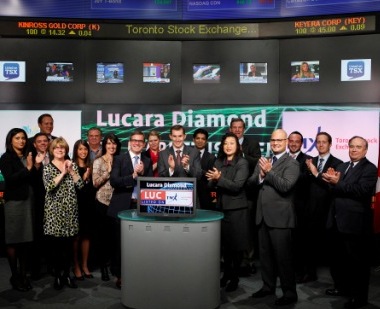
3. Lucara Diamond Corp. (TSX:LUC)
In March 2011, Lucara Diamond confirmed it was in talks with several companies in the diamond sector, including Gem Diamonds as it was evaluating merger alternatives. At the time, Gem Diamonds issued a somewhat prophetic statement, “These discussions are at a very early stage and there can be no certainty the contemplated merger will occur or of the timing or terms of any such transaction.”
At the time of the statement Cormark Securities analyst Matthew O’Keefe said, “I would take their press release at face value. This is a small space, everybody knows everybody else and they talk all the time.” By May, 2011 Gem Diamonds confirmed in a statement that discussions between the two companies had ended.
Lucara Diamonds is part of Lukas Lundin’s mining empire. The company has two key assets, specifically, the AK6 diamond mine in Botswana and the Mothae diamond mine in Lesotho. The 100% owned AK6 project is in the construction stage with mine, originally scheduled for commissioning to commence in the fourth quarter of 2011, now delayed until early 2012. The 75% owned Mothae mine is currently in the trial mining stage. Lucara also has a 49% interest in the Kavango diamond project in Namibia through it’s subsidiary Motapa.

In January earlier this year, Lukas Lundin, chairman of Lucara Diamond bought 215,000 shares in the public market between the prices of $1.05 and $1.10. He added to his position following the news of diamond sales from the company’s Mothae mine in Lesotho. Then on March 29 and 30, he bought one million shares in the public market at $1.20. We also note that in late February, chief executive officer William Lamb, the company’s President & CEO exercised 100,000 options and did not subsequently sell any shares. And a quick check on Canadian Insider shows more recent purchases at lower prices. Today, Lucara’s shares are trading just above 52 week lows at $0.83 resulting in a moderate paper-loss for the company’s Chairman.
I guess Mr. Lundin has been reading Suze Orman who writes, “By using the dollar-cost averaging technique, even if you’re investing for the long run (ten years or more), in the end you’ll be a winner.” Should we send Suze an email reminding her that not every stock goes up?
4. Mountain Province Diamonds Inc. (TSX:MPV)
On September 24th, 2010 Mountain Province Diamonds announced the results of the Feasibility Study on the Gahcho Kué diamond project located in Canada’s Northwest Territories. The study confirmed an operating mine life of 11 years based on an average annual production of approximately 4.5 million carats and initial capital costs in the range of $550 to $650 million. Thereafter, the company promptly raised $23 million at $5 per share providing the Mountain province with sufficient funds for its 2011 operating budget and a required $10 million payment to De Beers.
In partnership with De Beers, Mountain Province is developing, according to the company, the world’s largest and richest new diamond mine. And after 17 long years of development, the company is moving closer and closer towards production. De Beers is the world’s leader in diamond discover, development and mining. De Beers has been active in Canada since the early 1960s and is currently working on several exploration projects ranging from grassroots exploration to feasibility studies. De Beers Canada now has two established mines – the Snap Lake Mine and Victor Mine. Both mines were officially opened in July, 2008.
The Snap Lake Mine, De Beers’ first diamond mine outside of Africa, is built on the shore of Snap Lake 220 kilometres northeast of Yellowknife. The mine is Canada’s first completely underground diamond mine. While the Victor Mine is located in the James Bay Lowlands of Northern Ontario, approximately 90 kilometers west of the coastal community of Attawapiskat. Like Snap Lake, Gahcho Kué is located in Canada’s arctic.
Cathie Bolstad, spokesperson for De Beers Canada points out, different physical profiles of Snap Lake and Gahcho Kué will require different mining approaches. Whereas Snap Lake is a fully underground mine, Gahcho Kué is more reminiscent of the Ekati and Diavik diamond mines, which began their lives as traditional open-pit operations.
MiningFeeds.com recently connected with Patrick Evans, President & CEO of Mountian Province Diamonds, to discuss the company’s relationship with De Beers and their corporate development plans – CLICK HERE – to read more.
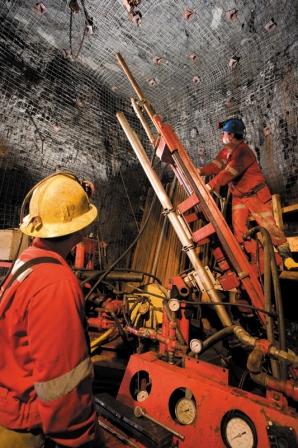
5. Shore Gold Inc. (TSX:SGF)
The Fort à la Corne area of Saskatchewan hosts an extensive kimberlite field and is the site of Shore Gold’s Star diamond project. Over 70 kimberlites exist in the Fort à la Corne forest and over 70 percent of these have been shown to contain diamonds. To date, NI 43-101 compliant Mineral Resource estimate for the explored portion of the Star Kimberlite is 20.5 million indicated carats and 3.1 million inferred carats. Total probable mine reserves of estimated at 34.4 million carats.
The past decade has been a wild ride for shareholders of Shore Gold. 10 years ago the company’s stock traded at $0.50 and, if I remember correctly, I purchased a private placement in the company at about that price. Five years later, when I was no longer a shareholder, shares of Shore Gold hit $8 a share. And now today, five years later, the company’s shares are again at $0.50. But as the quotable Baseball Hall of Fame catcher Yogi Berra once said, “It’s tough to make predictions, especially about the future.”
Predictions difficult? Barry Allan, senior analyst with Mackie Research would probably agree. Mr. Allan noted, “When Shore Gold originally discovered the kimberlites in the Fort a la Corne region… there were considerable question marks about whether there was potential for an economic diamond mine in Saskatchewan. The reason for that is these are somewhat different kinds of kimberlite or diamond inference kimberlite occurrences in the world — in the sense that they’re very different from what you find in other regions of Canada. They are very large, but relatively lower grade, compared to diamond deposits in Northern Canada, so the economic approach to exploiting these kinds of deposits is quite different.”
But after many years and many naysayers, Shore Gold released its Feasibility Study for the Star diamond project on July 14, 2011 confirming a NPV of $2.1 billion. But the massive scale and supporting economics may also be the biggest hurdle for the company when considering the up-front capital cost is expected to reach approximately $2 billion. For a company with a market cap of just over $100 million, accessing that amount of capital may prove somewhat challenging.
“It will take someone like Newmont Mining or (another) major mining company… someone like a BHP, Tech Cominco, or Rio Tinto to really have the horsepower. It will not be Shore Gold by itself,” said Mr. Allan. The Mackie Research analyst has a target price of $2 per share on the company’s stock assuming a “moneyed up, major mining company” steps in to help carry the ball across the goal line.
For 5 Diamond Stocks to Watch – Part 1 – CLICK HERE.

During the height of the financial crisis in November 2008, BHP Billiton elected to exercise its earn-in rights for the Chidliak diamond project. The price? $22.3-million in exploration over a two year period entitled the mining giant to a 51% interest in Peregrine Diamond’s biggest project. This marked a significant milestone in the company’s history and set the stage for a huge rally in the company’s share price from the $0.75 range to over $4.50. Since then, shares of Peregrine Diamonds have, over a three year period, trended back to the $1.00 mark.
Raymond Goldie, a senior mining analyst at Salman Partners, states in a report, “We note that BHP rarely enters into joint ventures with juniors, especially joint ventures in which the junior is, as is the case with Peregrine, the operator. BHP’s decision should not only increase the market’s confidence in the prospects of the Chidliak project, it should also increase the market’s confidence that the project can obtain financing through to production.”
A stable funding partner is a key part of the equation for a junior exploration and development diamond company since the average time frame from discovery to production is around 10 years and the costs are significant.
Is it time to revisit Peregrine Diamonds as an investor? We connected with Eric Friedland, younger brother to well-known mining venture capitalist Robert Friedland and CEO of Peregrine Diamonds, to find out what’s in store for the company.
Peregrine Diamonds was part of a bigger picture in 2005. Please talk about the genesis of the company and some of your major accomplishments to date.
In 2005, we bought the Altar copper and gold porphyry project in Argentina from Rio Tinto. Recognition of the significant potential value represented by Altar led to the spin-out of Peregrine Metals from Peregrine Diamonds, just prior to the Peregrine Diamonds IPO. Peregrine Metals conducted exploration throughout South America and advanced the Altar project as a private company until it went public in March, 2010. Peregrine Metals was subsequently sold in October, 2011 to Stillwater Mining.
Our diamond company went public in 2006. The exploration focus of Peregrine Diamonds started in the Northwest Territories and gradually shifted east to the Chidliak project on Baffin Island, Nunavut. Now, with the discovery in just four years of 59 kimberlites, seven of those with economic potential, and significant exploration upside, Chidliak is one of the most important diamond discoveries in the past two decades. A preliminary assessment of diamond value through bulk sampling next year and another year of exploration will help us gauge where it sits on a scale relative to the existing Canadian diamond mines.
You mention your sister company was recently purchased by Stillwater Mining in a transaction valued at US$487 million. Please tell our readers about the acquisition and what ancillary benefits, if any, have resulted from the sale.
In the spring, Stillwater conducted extensive legal and technical due diligence on the Altar project. They understood the value of the large copper-gold resource that had been identified and the significant upside offered by both the copper and gold exploration potential. Altar is a very big porphyry system that was only first drilled in 2003. There are very few large porphyry copper-gold systems in the world that are 100% controlled by junior exploration companies, especially at the Preliminary Economic Assessment stage. In May, Stillwater approached Peregrine Metals with a friendly acquisition proposal and a deal was finalized in June. The transaction was based on a value for the copper in the ground at Altar that was in-line with other recent transactions in the copper industry.
Peregrine Metals shareholders were supportive of the transaction. Many of those shareholders are also shareholders of Peregrine Diamonds. A number of directors, officers and employees of Peregrine Metals also hold positions with Peregrine Diamonds and are now fully focussed on adding significant value to Peregrine Diamonds.
Diamonds are generally considered to be a luxury item but, at the same time, they are very much a part of everyday life. What is your take on the diamond markets over the near term and what factors are expected to drive demand?
The long term fundamentals for diamonds are excellent, with demand rising while supply is diminishing. Of particular impact is the increase in demand in China and India as those countries continue their economic expansion. Diamonds are luxury items, but they are also working their way into the fabric of day to day living in the emerging economies. About 50% of weddings in China now feature diamond engagement rings, and it is as high as 80% in the major cities. In comparison, in 1989 it was difficult to buy diamond jewelry in China. When the economy falters, people may choose to delay large purchases and commitments, such as weddings, but life still goes on and this pent-up demand eventually gets satisfied. This is why the price of diamonds ran up so rapidly in the years following the global economic crisis.
We do not see any major mines the size of EKATI or Diavik (+ 100 million carats) coming onstream in the near future. Several of the world’s largest diamond mines are moving to underground operations in the coming year, in order to extend their mine life. All these factors point to supply constraint and higher prices in the coming years. Chidliak is very important because it comes at a time when there are very few diamond projects in the world ready for development. Since the discovery of Chidliak in 2008, there have been no new discoveries of diamond districts anywhere in the world that we know of.
Peregrine’s properties are located in the Canadian Arctic. What are some of the benefits and drawbacks associated with doing business in the deep north?
There are definitely challenges that need to be considered when you mine in the Arctic. This is where the experience of our joint venture partner, BHP Billiton, will be invaluable. BHP Billiton owns 80% and operates the EKATI Diamond Mine in the Northwest Territories, in a similar Arctic environment to Chidliak. We believe the setting at Chidliak on south Baffin Island would be quite complimentary to a diamond mining operation. The land where most of our kimberlites with economic potential have been discovered is relatively flat with far fewer lakes than in the Lac de Gras region of the NWT. Chidliak is located only 100 km from Iqaluit, Nunavut’s capital. A year-round or seasonal road from the capital to the project is a real possibility. Supplies can be shipped to Iqaluit by sea, a cost-effective form of transportation.
I believe it is recognized in the far north that mining offers great opportunities for significant economic gains in the region. The economic data from the three diamond mines in the Northwest Territories makes that clear. The local population and political leadership in Nunavut are keen to see economic benefits similar to those experienced by their neighbours to the west.
What is the nature of your relationship with BHP Billiton and do you plan on expanding or developing additional industry relationships going forward?
We have an excellent relationship with BHP Billiton, and our project will continue to benefit from their technical, Arctic mining and diamond marketing expertise which was derived from exploring, developing and operating one of the world’s most important diamond mines, EKATI. BHP has a 51% participating interest in the Chidliak joint venture with Peregrine owning the remaining 49%. The fact that BHP Billiton has allowed Peregrine to continue to be the operator at Chidliak speaks volumes about the strength of this relationship and the quality of our operational personnel. Peregrine has full marketing rights to its share of diamond production which would allow us to establish a fully integrated diamond company, taking diamonds from the mine to the consumer.
Overall, we are very satisfied with our relationship with BHP Billiton and with five joint venture partners we have on other exploration projects. Joint venture and business relationships can be very beneficial, especially with the inherent risks of diamond exploration, and as we grow and evolve, we are always open to establishing new relationships that we think could benefit our shareholders.
What major milestones are on the horizon for Peregrine as we head into 2012?
The 2011 drilling of over 5,500 metres on six kimberlites with economic potential, and extensive logistical planning and arrangements, have set the stage for bulk sampling of select kimberlites by way of large diameter reverse circulation drilling, which is scheduled to commence in the first quarter of 2012. Equipment, supplies and fuel are have been shipped to Iqaluit by sealift and bulk sample site layouts and access trails have been mapped, The bulk sampling program aims to extract roughly 200-carat diamond parcels from at least three kimberlites to allow the first diamond valuations at Chidliak, a crucial step towards confirming the economic viability of the project.
The 2012 bulk sampling program is an important step along the development path at Chidliak and it will allow Peregrine to continue to unlock the value at this exciting diamond project. Our goal is to deliver the first diamond mine on Baffin Island. We will work to achieve this goal by rapidly advancing the known kimberlites with economic potential as well as continuing to explore for additional diamondiferous pipes. Unresolved kimberlite indicator mineral trains and the presence of kimberlite float at multiple localities not currently linked to sources give us confidence that more kimberlites will be discovered next season.
Concurrent with advancing Chidliak, Peregrine will continue to explore its other properties in the north. These include Cumberland and Qilaq, near Chidliak on south Baffin Island, Nanuq and Nanuq North, 850 kilometres west of Chidliak in Nunavut, and our highly prospective Lac de Gras region land package in the Northwest Territories, near the Diavik and EKATI diamond mines, which includes our 73% owned, nine hectare DO-27 kimberlite pipe that has a diamond resource of 18.2 million carats plus a potential mineral deposit of 6.5 to 8.5 million tonnes of kimberlite. We are looking forward to a very busy and fruitful 2012.
This interview was featured in the article 5 Diamond Stocks to Watch – Part 1 – CLICK HERE to read more.
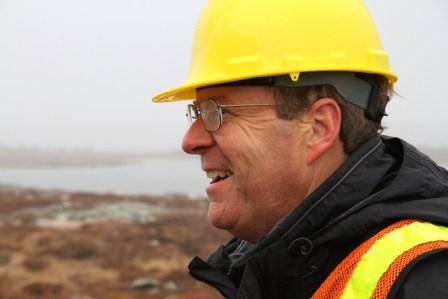
On September 24th, 2010 Mountain Province Diamonds announced the results of the Feasibility Study on the Gahcho Kué diamond project located in Canada’s Northwest Territories. The study confirmed an operating mine life of 11 years based on an average annual production of approximately 4.5 million carats and initial capital costs in the range of $550 to $650 million. Thereafter, the company promptly raised $23 million at $5 per share providing the Mountain province with sufficient funds for its 2011 operating budget and a required $10 million payment to De Beers.
In partnership with De Beers, Mountain Province is developing, according to the company, the world’s largest and richest new diamond mine. And after 17 long years of development, the company is moving closer and closer towards production. De Beers is the world’s leader in diamond discovery, development and mining. De Beers has been active in Canada since the early 1960s and is currently working on several exploration projects ranging from grassroots exploration to feasibility studies. De Beers Canada now has two established mines – the Snap Lake Mine and Victor Mine. Both mines were officially opened in July, 2008.
The Snap Lake Mine, De Beers’ first diamond mine outside of Africa, is built on the shore of Snap Lake 220 kilometres northeast of Yellowknife. The mine is Canada’s first completely underground diamond mine. While the Victor Mine is located in the James Bay Lowlands of Northern Ontario, approximately 90 kilometers west of the coastal community of Attawapiskat. Like Snap Lake, Gahcho Kué is located in Canada’s arctic.
Cathie Bolstad, spokesperson for De Beers Canada points out, different physical profiles of Snap Lake and Gahcho Kué will require different mining approaches. Whereas Snap Lake is a fully underground mine, Gahcho Kué is more reminiscent of the Ekati and Diavik diamond mines, which began their lives as traditional open-pit operations.
MiningFeeds.com recently connected with Patrick Evans, President & CEO of Mountain Province Diamonds, to discuss the company’s relationship with De Beers and their corporate development plans.
Thanks for joining us Patrick, please tell our readers, in general terms, about Mountain Province and the structure of the company.
Mountain Province Diamonds controls 49 percent of the world’s largest and richest new diamond development project at Kennady Lake in the diamond fields of Canada’s Northwest Territories. Partnered with De Beers, the leading global diamond company, the joint venture is permitting a first mine that will produce approximately 4.5 million carats per year from open-pit for an initial 11 years. Gahcho Kué (“Place of Big Rabbits”) will be Canada’s fifth diamond mine and the fourth in the Northwest Territories.
Mountain Province originally discovered diamond-bearing kimberlite in the mid-1990s when there was a “diamond rush” in Canada. Please talk about those exciting times in comparison to where the company is at today.
Mountain Province staked the properties at Kennady Lake during Canada’s diamond rush 20 years ago and discovered the first kimberlite – 5034 – in 1994. This was a remarkable achievement. It’s about ten times more difficult to find a diamond mine than it is to find a gold mine. Also, only 1 percent of diamond discoveries have the grade to support a diamond mine. Today, the 5034 kimberlite has a reserve grade of nearly 2 carats per tonne and contains more than 23 million carats for an in-situ value of over $4.2 billion.
Does having a majority partner, albeit a world-class partner in De beers, limit the company in any way?
Mountain Province entered into a JV with De Beers in 1995 under which it could earned a 51 percent interest in Gahcho Kué. De Beers discovered a further six kimberlites, three of which (5034, Hearne and Tuzo) have a Probable Reserve of 31.2 million tonnes with a fully diluted mining grade of 1.57 carats per tonne for a total reserve of 49 million carats. At April 2011 actual diamond prices of $185 per carat, this represents in-situ value of more than $9 billion!
Mountain Province is De Beers’ largest commercial mining partner. Although it’s a 49/51 JV, all material decisions require the approval of both partners, so it effectively operates as a 50/50 JV. Each partner will market its own share of the diamond production, which gives Mountain Province control over the marketing of more than 2 million carats a year. Based on April 2011 diamond prices of $185 per carat, Mountain Province will have control of revenue of more than $370 million a year. With operating costs projected at approximately $30 per carat, this represents an operating margin of over 80 percent. And the company’s current market cap is a mere $350 million.
You recently announced two major exploration programs at Kennady Lake – the planned Kennady North airborne gravity survey and the Tuzo Deep drill program. What are the key points associated with each program?
De Beers and Mountain Province have just completed an airborne gravity survey over both Gahcho Kué as well as Mountain Province’s 100%-controlled Kennady North Project, which is immediately to the north and west of Gahcho Kué and more than three times the surface area. With the preliminary results expected before the end of November, it’s expected that additional kimberlites will be identified which will be the subject of further exploration to increase the size of what’s already the world’s largest new diamond development project.
In addition, the Joint Venture is currently drilling the six-hole Tuzo Deep program designed to define an underground resource from 350 (the base of the current 21 million carat Tuzo resource) to 750 metres. If successful, the Tuzo Deep program has the potential to add materially to both the Gahcho Kué resource as well as the projected mine life. The Tuzo Deep drill program is expected to be completed in early 2012 and thereafter the results will be announced.
It is no secret that you’ve been in discussions with third parties who are interested in Mountain Province. However, you elected to cease discussions before the results of these exploration programs have been announced. If you read between the lines one can assume that the board is open to an acquisition – is that a fair assumption?
Given the size and quality of the Gahcho Kué asset, as well as the potential to materially increase the resource of what’s already the world’s largest and richest new diamond mine development, it’s hardly surprising that Mountain Province has attracted the attention of the leading diamond producers seeking to add to their rapidly diminishing resources. Despite this unsolicited attention, Mountain Province is determined to remain in control of its destiny at least until the full value of its assets has been established. Accordingly, Mountain Province unilaterally suspended discussions with third parties pending the results of the Tuzo Deep program and the airborne gravity survey. Once the results of these programs are in the public domain and shareholders have a better idea of the value of the company’s assets, Mountain Province will re-engage with third parties to explore value-enhancing opportunities.
For investors looking at investing in this sector for the first time, what are some of the key factors to consider and what sets Mountain Province apart for other companies?
While economic diamonds deposits are undoubtedly the most difficult to discover, they offer amongst the highest margins of any commodity. Despite more than 20 years of exploration costing hundreds of millions of dollars, Gahcho Kué was the last major diamond discovery. No discovery since then can compete with the size and quality of Gahcho Kué. Growing demand, particularly in India and China, has driven the industry into a supply deficit which has resulted in annual double-digit price increases. Given that it takes on average ten years from discovery to production from a new diamond mine, the supply deficit is likely to grow and provide strong price support for Gahcho Kué future diamond production.
This interview was featured in the article 5 Diamond Stocks to Watch – Part 2 – CLICK HERE to read more.
If you would like to receive our free newsletter via email, simply enter your email address below & click subscribe.
CONNECT WITH US
Tweets
Tweet with hash tag #miningfeeds or @miningfeeds and your tweets will be displayed across this site.
MOST ACTIVE MINING STOCKS
Daily Gainers
 Lincoln Minerals Limited Lincoln Minerals Limited |
LML.AX | +125.00% |
      |
GCR.AX | +33.33% |
      |
CASA.V | +30.00% |
      |
AHN.AX | +22.22% |
      |
ADD.AX | +22.22% |
      |
AZM.V | +21.98% |
      |
NSE.V | +21.05% |
      |
DYG.V | +18.42% |
      |
AAZ.V | +18.18% |
      |
GLA.AX | +17.65% |

 Follow us on Twitter
Follow us on Twitter Become our facebook fan
Become our facebook fan








